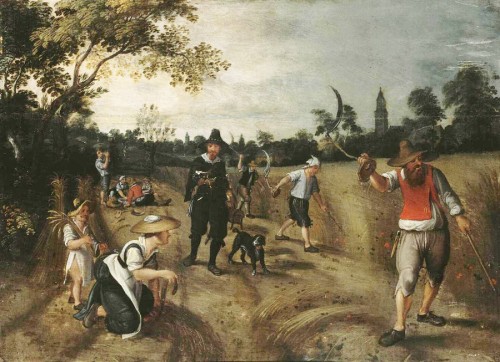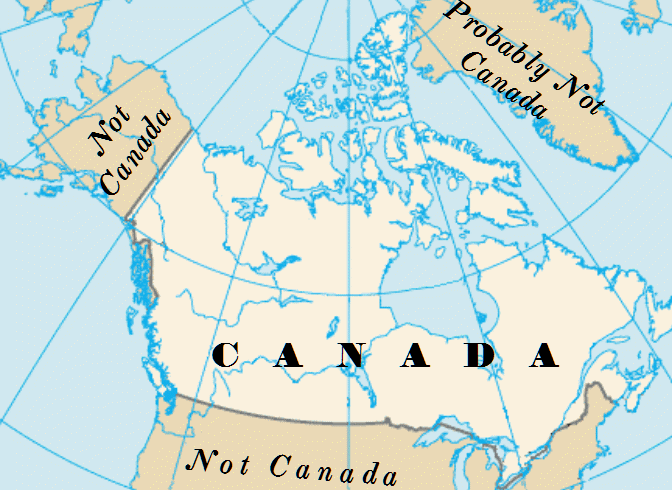Posts filed under “Travel”
LET’S VISIT CANADA.
Part 4.—What to See in Newfoundland and Labrador.
Newfoundland and Labrador is Canada’s most recent province. It was an independent dominion for a while, but bungled independence so thoroughly that it had to be repossessed by the British government. It did not join Canada until 1949, and even then was not too sure about it.
The capital is St. John’s, which is the oldest city in North America if you discount certain other older cities. St. John’s is a vibrant cultural hub with endless opportunities for entertainment; for example, right now, the entire city is obsessed with a pine warbler.
At the very northern end of Newfoundland is L’Anse aux Meadows, famous as the site of the only thoroughly investigated Viking settlement in North America. You can still see the nutshells and Swedish Fish wrappers left behind by the settlers.
Along the coast of Newfoundland are many picturesque fishing villages, where you can watch the locals engaging in the quaint local tradition of not fishing, celebrated since the collapse of the North Atlantic cod fishery in the late twentieth century.
Labrador is home to Churchill Falls, which at one time was known as one of the most spectacular sights in North America. It was decided, however, that it could be more useful than ornamental; and since the Churchill River was redirected for power generation, the waterfall looks like this:
Quebec has never recognized the border with Labrador as it is currently drawn, and since the alternative border makes Labrador a thin ribbon extending one English mile inland from the high-tide mark (see the map above), you may be able to see Québécois troops massing across the border if you visit Labrador City. What fun!
LET’S VISIT CANADA.
Photograph by W. Lloyd MacKenzie, via Flickr @ http://www.flickr.com/photos/saffron_blaze/
—
Part 3.—Canadian Government.
Canada is a federation consisting of nine provinces, three territories, and Quebec, which is an alternate universe in which Montcalm defeated Wolfe. The form of government is a parliamentary democracy, which lasts exactly as long as Queen Elizabeth is in an indulgent mood.
The Head of State is the Queen of Canada, Elizabeth II. She is also Head of State of each of the individual provinces, so she has quite a bit of state-heading to do. Of course, Elizabeth is also Queen of a large number of other countries, which spreads her a bit thin. Canada is actually the largest of her dominions, but we must remember that most of Canada is useless. Approximately 87.2% of the population lives within a hundred miles of the U. S. border; the rest of the country is populated mostly by moose.
The Queen is represented in Canada by a Governor General, whose job is to open sessions of parliament and make sure the Queen gets the hats people send her.
Because Canada is not within easy commuting distance of her house, Queen Elizabeth tends not to pay very much attention to it, which allows Canadian politicians to play at running the country uninterrupted for years at a time. Every once in a while, the Queen notices Canada and squashes its parliament with her parliament-squashing mallet. Then the whole government has to be started over from scratch.
The capital of Canada is Ottawa, a tiny trading post picked by Queen Victoria as a joke. Her deadpan delivery caused her Canadian subjects to take her seriously, however, and they dutifully commenced filling the backwoods trading post with great Gothic stone palaces fit for a queen. Today Ottawa remains a backwoods trading post with Gothic palaces, in tribute to Canada’s beloved Queen Victoria, the Mother of Confederation.
Until recently, the Canadian government was elected by the people to represent their interests. In common with other capitalist democracies, however, Canada has moved to a system in which the government is elected by large corporations to protect themselves from the people.
Visitors to Canada are encouraged to enjoy Canadian government as a spectator sport, but discouraged from participating directly.
LET’S VISIT CANADA.
Part 2.—Entrance Requirements.
Technically, Canada is not the same country as the United States, so if you are a U. S. citizen, you will need to meet certain requirements in order to cross the border:
1. Make sure you have a passport. This is not a Canadian requirement; Canadians generally trust U. S. citizens, and would be happy to let them into the country with a smile and a wave. The United States, however, believes that U. S. citizens are probably terrorists unless they can prove otherwise. You will thus need a passport to get back into the United States, or you will be forced to join the thousands of stateless Americans in the refugee camp for U. S. citizens who forgot their passports, which is currently located on Baffin Island.
2. Make sure your vaccinations are up to date. Canadians are notoriously courteous and hospitable, and no one wants that kind of thing brought back into the United States.
3. Bring a pair of xylophone mallets, for obvious reasons.
4. Did you remember a hat for Queen Elizabeth?
5. To avoid difficulty at the border when re-entering the United States. make sure your skin is not of an unpatriotically dark hue. Also be sure not to profess any obviously anti-American beliefs, such as Islam, Hinduism, Episcopalianism, or global warming.
Note that, if you are a Canadian citizen, there is a high statistical probability that you are already in Canada. It is advisable to check before making further plans to enter the country.
LET’S VISIT CANADA.
Part 1.—What to Bring with You.
When planning a visit to our friendly neighbor to the north, you will make your trip much more enjoyable if you stock up on a few essential supplies before you leave.
Money. Canada’s economy is based on a modification of the capitalist system, in which a socialist paradise for Canadian citizens is funded by selling souvenir keychains to American tourists. You should also be aware that Canadians use cartoon money—bills in bright colors and dollar coins called loonies. You will feel much better having real American money in your pocket.
Comfortable clothes. Except in the large cities, Canadians disapprove of uncomfortable clothes.
A curling iron, in case you wish to participate in the Canadian national sport of curling.
A pair of xylophone mallets. You will understand when you get there.
A nice gift for Queen Elizabeth. The Governor General will make sure it gets to her. She likes hats.
Snowshoes. They will give the border guards a good laugh.
Weather. Especially in the winter, most of Canada’s weather escapes across the border to the United States, creating a serious and at times worrying weather deficit in Canada. Canadians will be glad to have some of their weather returned, and may even buy it back from you at inflated prices.
Bacon. Canadian “bacon” is a completely unsatisfactory bacon substitute. Real American bacon can often be used as currency when purchasing souvenir keychains from the bacon-deprived natives.
THANKSGIVING AROUND THE WORLD.

The American holiday we call Thanksgiving has equivalents all around the world, reflecting the natural human desire to express gratitude to a higher power by means of selfish overindulgence.
In Merry England, the ancient Saxons used to celebrate Thanksgiving every year by sacrificing an investment banker to Thor.
In Quebec, Thanksgiving is known as “Le Jour de l’Action de grâce,” in keeping with the provincial government’s policy of assuring the dominance of the French language through sheer multiplication of words.
The Kirk of Scotland long ago banned all expressions of thanksgiving for earthly goods, on the grounds that God intends us to be miserable.
In antipodean South Africa, the Thanksgiving turkey is served upside-down, with the stuffing on the outside.
In North Korea, every day is Thanksgiving and Christmas and New Year’s and Arbor Day and Easter and your birthday.
In China, on the People’s Day of Gratitude, the citizens come together and think of something nice to give the General Secretary. Usually it’s a necktie.
FUN FACTS ABOUT CHICAGO.

The Willis Tower (formerly the Sears Tower) is the tallest free-standing structure in the Upper Midwest.
Many of Chicago’s famous elevated trains run underground.
The L is the only major transit system in North America, and possibly the world, that has a Pink Line.
Chicago’s nickname, “Second City,” refers to its being the second-largest city in the United States (after Los Angeles) that is not New York.
Every day, the Chicago Mercantile Exchange sets the price for a U. S. senator, a U. S. representative, an Illinois governor, and many other important officials.
Chicago controls the food prices for the entire world, but fortunately no one would ever use that power for evil.
From DR. BOLI’S ENCYCLOPEDIA OF MISINFORMATION,
ASK DR. BOLI.
Dear Dr. Boli: I was cleaning off unwanted papers from my desk the other day when I suddenly realized I had unknowingly run my bucket list through the shredder!
My wife tells me, “When life gives you confetti, throw yourself a party.” But I am still feeling quite listless.
Please, sir, have you any other words of wisdom to console me as I attempt to piece back together my broken dreams? —Signed, Nore Roderick
 Dear Sir: Any respectable bucket list would have to begin with the famous bucket that Warren G. Harding kicked in 1923. It is displayed in the lobby of the Commonwealth Building on K Street in Washington.
Dear Sir: Any respectable bucket list would have to begin with the famous bucket that Warren G. Harding kicked in 1923. It is displayed in the lobby of the Commonwealth Building on K Street in Washington.
The list would also have to include the bucket with a hole in it that inspired both Louis Armstrong and Hank Williams to song. It is currently for sale on eBay, but so far no bidder has been able to meet the reserve.
The bucket which Booker T. Washington cast down may be seen on application to the custodian at the Booker T. Washington National Monument in Hardy, Virginia.
The gutbucket played by Will Shade in the Memphis Jug Band is not on display anywhere at the moment, but it can still be heard on numerous recordings.
The first bucket seat in Pittsburgh can be found in a Lincoln limousine that once belonged to Helen Clay Frick, now on display at the Frick Car and Carriage Museum. The Lincoln is an exceptionally long car, and the bucket seat was used to hold the long-distance operator who connected Miss Frick with her chauffeur.
This short list may not be a complete replacement for the one you lost, but it should at least give you a head start on compiling a new one.
ASK DR. BOLI.
Dear Dr. Boli: I’m flying to St. Louis next week, and I wanted to take some good tea with me. Since you’re well known as a man with opinions about tea, I thought I’d ask you: What kind of tea can I take that will make airport security fun again? —Sincerely, Aldus P. Castleton, Fox Chapel.
Dear Sir: This is the tea you need.
WEDDING CUSTOMS AROUND THE WORLD.
In Sydney Mines, Nova Scotia, the wedding ceremony is completed when the bride and groom exchange and discard traditional gifts of pickled herring.
In the Fortunate Isles, every dish at the wedding-feast must include lingonberries, imported from Scandinavia at almost ruinous expense.
Brides in Milan will not specify a wedding gown until they have made themselves thoroughly familiar with the latest fashions from Boise, Idaho.
In Mmadinare, Botswana, a marriage cannot be solemnized until the bride has acquired a library card under her new name.
In Glassport, Penna., the traditional wedding brawl often involves police from as many as three neighboring boroughs and townships.





